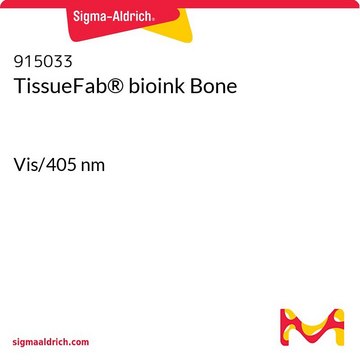推荐产品
正在寻找类似产品? 访问 产品对比指南
應用
TissueFab® - Bone support bioink is suitable for printing bone scaffold or using as a supporting bioink for bone specific hydrogel/matrix bioink. It is formulated with optimal ratio of PCL and HAp, which shows excellent printability and osteogenic bioactivity. Polycaprolactone (PCL) is a synthetic biodegradable polymer that has been widely used as 3D printed bone scaffold material. Hydroxyapatite (HAp) has a chemical similarity with the mineralized phase of bone which accounts for their excellent biocompatibility and osteoinductive and osteoconductive properties favorable for bone regeneration.
包裝
5g in glass bottle
法律資訊
TISSUEFAB is a registered trademark of Merck KGaA, Darmstadt, Germany
儲存類別代碼
11 - Combustible Solids
水污染物質分類(WGK)
WGK 3
Liang Dong et al.
Scientific reports, 7(1), 13412-13412 (2017-10-19)
Synthetic polymeric scaffolds are commonly used in bone tissue engineering (BTE) due to their biocompatibility and adequate mechanical properties. However, their hydrophobicity and the lack of specific cell recognition sites confined their practical application. In this study, to improve the
Boontharika Chuenjitkuntaworn et al.
Journal of biomedical materials research. Part A, 94(1), 241-251 (2010-02-19)
Polycaprolactone (PCL) is a synthetic biodegradable polymer that has been approved for use as bone graft substitutes. In this study, PCL scaffolds incorporating hydroxyapatite (HAp) particles were fabricated by combined solvent casting and particulate leaching techniques. The average pore dimension
Mitchell A Kuss et al.
RSC advances, 7(47), 29312-29320 (2017-07-04)
Reconstruction of complex, craniofacial bone defects often requires autogenous vascularized bone grafts, and still remains a challenge today. In order to address this issue, we isolated the stromal vascular fraction (SVF) from adipose tissues and maintained the phenotypes and the
我们的科学家团队拥有各种研究领域经验,包括生命科学、材料科学、化学合成、色谱、分析及许多其他领域.
联系技术服务部门







